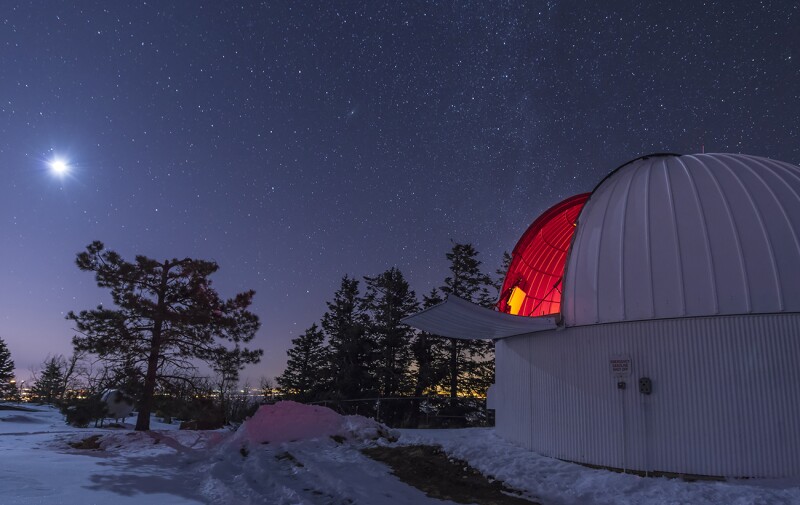Throughout history, people have looked to the stars for answers. Over the years, the twinkling pinpoints of light have inspired everything from exploration and science to art and religion. But we’re losing them: The world is getting brighter by the year, and most of us—about 80 percent globally and 99 percent in the United States—now live in a fog of light pollution.
Perhaps in direct response, astro-tourism is on the rise, with travelers eager to trade overly bright nights for inky, star-studded skies. Many people travel to Arizona, which has an average of 350 clear nights per year and, as a result, some of the best stargazing in the country.
The Grand Canyon State has long attracted individuals wishing to enjoy, study, and preserve dark skies. In 1988, two Tucson residents—amateur stargazer Tim Hunter and professional astronomer David Crawford—teamed up to found the International Dark-Sky Association (IDA). Now present in 18 countries, the organization is best known for its International Dark Sky Places program, which recognizes sites around the world that are using “responsible lighting policies and public education” to preserve and protect night skies.
With 16 designated parks, reserves, and communities, Arizona is home to a greater number of Dark Sky sites than anywhere else in the nation. The state also features some of the world’s best observatories and a culture that celebrates stargazing, making it an ideal place to escape the excessive illumination of modern life. Read on for our favorite ways to experience Arizona’s dark skies.
Camp in the parks
Becoming an official Dark Sky park, reserve, or sanctuary is no easy task. In addition to the standard requirements around programming and education, these natural areas—some remote, others on the edge of populated communities—must “meet certain sky quality measurements so that anyone going to visit that place knows they’ll experience [a certain level] of darkness,” says IDA director of Communications Amanda Gormley. As such, they’re where you’re most likely to spy the Milky Way while camping under the stars.
Arizona has 10 International Dark Sky Parks, including Grand Canyon National Park and Parashant National Monument in the north, Kartchner Caverns State Park and Tumacácori National Historic Park in the south, and Petrified Forest National Park in the east. The most recent addition, Tonto National Monument (approved in May 2019), sits toward the center of the state, two hours east of Phoenix.
Need to know: All of these sites offer exceptional conditions for stargazing, but Gormley recommends reaching out to individual parks before visiting. “Often they have public star parties and other activities to engage with, but not all places are accessible every night,” she says. While Arizona’s clear skies mean campers have a good chance of seeing constellations just about any night, those who prefer to have access to telescopes or the expertise of an astronomer should plan ahead.
Go urban stargazing
If camping and wilderness excursions aren’t your thing, you can still see some serious stars in Arizona’s cities. The state is home to six International Dark Sky Communities, including Sedona and Flagstaff, the world’s first city to earn the designation. These populated places aren’t as dark as the parks, but they tend to have progressive lighting infrastructure and educational programming available to the public. For example, visitors to Flagstaff will find monthly star parties in Heritage Square and regular observation events in Buffalo Park, hosted by the Coconino Astronomical Society.
Although most of the state’s Dark Sky Communities are up north, travelers in central and southern Arizona aren’t completely out of luck. In Tucson’s buzzing University District, Sky Bar offers astronomer-guided viewings on Thursday through Sunday evenings, weather permitting. And the city’s oldest resort, Westward Look, keeps a Celestron 2000 telescope on hand for guests to use at their leisure.

At Mountain Shadows Resort Scottsdale, guests can mingle at astrology-themed cocktail receptions under the stars.
Courtesy of Mountain Shadows Resort Scottsdale
Some hotels, such as Mountain Shadows Resort Scottsdale, are even introducing star-centric programs. Set at the base of Camelback Mountain, the resort offers astrology-themed cocktail receptions on the rooftop deck, “Sipnics Under the Stars” on the golf course, and special Stars Aligned packages that include a customized celestial map and private stargazing session with an astronomer.
Need to know: Because these are populous cities, there will be some light pollution, but with the help of telescopes and knowledgeable guides, you may still spot a planet or even Orion’s Nebula.
Check out the observatories
For more than a century, serious astronomers have flocked to Arizona to study the skies. The state is home to some of the nation’s most significant—and historic—observatories, several of which are open to the public for after-dark experiences.
Built in 1864, Flagstaff’s Lowell Observatory is among the oldest in the country. Most days of the week, the historic museum hosts a wide range of programming, including 30-minute constellation tours and telescope viewings in the Giovale Open Deck Observatory.

Attend an astronomy lecture at the University of Arizona’s Mount Lemmon SkyCenter.
Photo by John A Davis/Shutterstock
Informally known as the “astronomy capital of the world,” the Tucson area is home to two visitor-friendly observatories: University of Arizona’s Mount Lemmon SkyCenter, located about 90 minutes northeast of the city, and Kitt Peak National Observatory, roughly an hour west. At 9,157 feet, the SkyCenter takes advantage of its altitude to offer a five-hour SkyNights program most Thursday through Sunday evenings. The experience includes an astronomy lecture followed by a guided exploration of the night sky using binoculars, charts, and two of the largest public outreach telescopes in the Southwest.
Sitting at almost 7,000 feet on the Tohono O’odham Nation, Kitt Peak National Observatory has worked to make astronomy more accessible to the public since its founding in 1964. These days, the observatory offers the family-friendly Nightly Observing Program; the intermediate Dark Sky Discovery Program; the small-group exploration, Night of the Marvelous Moon; and the private, customized Overnight Telescope Observing Program.
Need to know: You can walk into these observatories during regular daytime hours, but book ahead for after-dark experiences.
>>Next: Plan Your Trip With AFAR’s Travel Guide to Arizona











